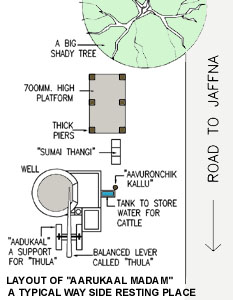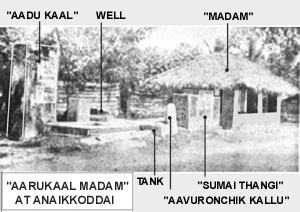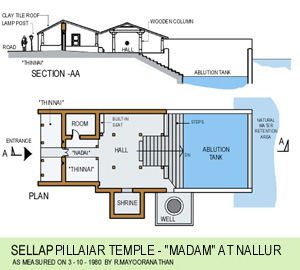 |
 |
||||||||||||||||||
|
Miscellaneous Building Types This chapter will only introduce a few traditional buildings and building types. No analysis is attempted as the information available with me now is inadequate. This page will be updated later when further information become available. Resting Houses or "Madams" In these pages the 'resting house' or 'resting place' means all the buildings which are referred by the Tamil word "Madam". The resting houses found in Jaffna can be categorized into the following types. 1. Way-side resting
places Way-side resting places Numerous resting houses which belong to this category had been found along all major roads in the Jaffna region. Many of these are now in ruins or demolished. Many place names such as "Ottu madam", "Aarukal madam", "Saanthaiyar madam", "Madaththadi" "Maruthanar madam" etc., still remind us the way-side resting houses once stood there. In those days, when many people used to travel even long distances by foot, sometimes with their agricultural produce on their heads, these resting places were very much useful. Many others who use bullock carts for traveling and transportation of goods also needed such places to feed their animals and give them some rest on the way specially during hot summer months. . A standard way-side resting place of Jaffna consisted of the following elements "Madam" proper The simplest form of this is a shelter with its floor, raised by
about 2' 6" above the ground level, the edge of which functions as a comfortable seat
or bed for a tired passer well Most part of the Jaffna peninsula has good ground water at comparatively lower depths. As Jaffna has no river, the wells are the major source of good water. Therefore wells form an essential part of way-side resting places in Jaffna. These wells were generally provided with a lever system called "thula", to draw water manually from the well, and other related elements. In addition to the wells, "Sellap Pillaiyar" temple "madam" and some other similar resting places had tanks, resembling ablution tanks found in Hindu temples of South India and Jaffna. Water tank One can see a small built-in water tank next to these wells meant for stray animals such as cows and goats and similarly for animals, like bulls and horses which accompany those who travel by animal drawn carts. "Sumai thaangi" "Sumaithangi" is about 2 feet thick and 5 to 6 feet wide stone built wall like structure, top of which is shaped to look like a victory stand used in sports events. This structure was intended as a place to temporarily unload burden carried by passers-by on their heads or shoulders. Therefore the height at it's maximum point is made to level with an average person's height to ensure an easy transfer of loads between the platform and the bearer's head without other's help. Similarly the lower level is meant for loads carried on shoulders. It is said that, in those days the "sumaithangi" structures were built in memory of women who die during pregnancy or delivery. "Aavuronchi kallu" A lime stone piece, made into a tapered cylindrical shape of about 3 feet and 6 inches high, can be seen erected near the water tank, was meant for the cattle to rub their body. This is referred as "Aavuronchi kallu" in Tamil language. A large tree It is logical to state that the large shady trees were the simplest form of resting places. They represent the inception of later developments. In all probability the well and other structures would have been built next to the trees, which were already in use as resting locations, as extensions to the then existing facility. However the shady trees continued to remain part of the complex, as they were useful in keeping the environment cool and pleasant and they still provided the much needed shade for the accompanying animals to rest.
Resting houses near market places It seems that in those days many market centres had resting places closer to them. Agricultural and other produce were directly brought to the markets by the farmers from distant villages also. Some traders too had to travel from one market place to another as many of the Jaffna's major markets did not function daily. They functioned once or twice a week only, but in a staggered schedule. These traders ended up in traveling many kilometers daily with their goods. Therefore resting places near the market places would have been a very essential item. Resting house near Jaffna market An interesting and comparatively big building known by the name of "Ganga Saththiram" ( "Saththiram" is another Tamil word for "Madam" - a resting house) was standing near the Jaffna old market at Kankesnthurai road, Hospital road Janction till about two decades ago. The above junction was referred as "Saththiraththu Santhy" after this resting house. The building reflected the colonial architectural style adopted for traditional planning concepts. A well in the centre of an open space covered by a circular arcaded high wall with a series of arched openings at the higher level provided a very interesting architectural space. In fact the space had been divided by a wall which ran through the middle of the well to make provision to use it from inside the building as well as from out side. Part of the building was of two floors. The concept of "thinnai" found in most of the traditional buildings had been utilized here too. The building consisted of several rooms. When I visited in 1974, this building was being used for purposes different from which it was intended for. The information gathered did not throw much light on the original functions of internal spaces. However there was evidences of the provision of cooking facilities. Further there were some paintings based on Hindu religious themes on the interior walls. The period of these paintings is not known. Probably they were done much later after the completion of the building. Unfortunately I do not have a plan of this building with me at present. I have done some sketches of the plan if not a measured drawing. If my documents are intact back at home, in future this document can be updated with the above plan. Resting places near Temples and pilgrimage centres Resting places of various sizes with different types of facilities are found near many temples in Jaffna peninsula. Some are being out of use at present and others still function with reduced scopes. Among others the resting places near "Selva sannathy" temple at Thondamanaru are well known. Similarly, The resting places at Keerimalai near the historic stream and the "Naguleswarar" temple also are known throughout Jaffna peninsula and out side. "Vaithilingam Madam" and "Srappar Madam" at Keerimalai are noteworthy. I have no knowledge on the present condition of these buildings. Vaithilingam Madam This building had been partially in neglected condition, long before the area lost its importance as an active pilgrimage spot.
On the left side of the building the cooking spaces are arranged around a narrow court yard. This arrangement resemble a type of houses with two court yards, found in Vannarponnai, which was discussed under the heading "Court yard houses" in this document.
|
||||||||||||||||||
| Last updated on 04 February 2005 | |||||||||||||||||||
| YOUR VISITOR NO. TO THIS SITE IS |
|||||||||||||||||||

 by. Generally four or more columns provided to
support a roof, covered with clay tiles or leaves of coconut or palmyrah palms. At a
higher level of development of the way side resting places, this building was provided
with one or two lockable rooms and in design it resemble the front portion of a
traditional court yard house with elements such as "thinnai" and
"nadai". "Poothar madam" at Kopay along Jaffna- Point Pedro road and
"Sellap Pillaiyar temple madam" at Nallur can be cited as good example for this
type. The first, I hope is still standing in a dilapidated condition and the other had
been demolished about ten years back.
by. Generally four or more columns provided to
support a roof, covered with clay tiles or leaves of coconut or palmyrah palms. At a
higher level of development of the way side resting places, this building was provided
with one or two lockable rooms and in design it resemble the front portion of a
traditional court yard house with elements such as "thinnai" and
"nadai". "Poothar madam" at Kopay along Jaffna- Point Pedro road and
"Sellap Pillaiyar temple madam" at Nallur can be cited as good example for this
type. The first, I hope is still standing in a dilapidated condition and the other had
been demolished about ten years back. 
 There are about 25 small
rooms all laid out around a large, open central court yard. These rooms are overlooking
the court yard through a verandah. As the rooms are very small these would have been
intended for safe-keeping possessions of the pilgrims. A columnar pavilion is located in
the centre of the court yard. It seems that this had been a venue for lectures and other
events during days of special religious significance. The building is entered through a
porch onto the front verandah. From here a door way leading to the court yard area through
a small hall.
There are about 25 small
rooms all laid out around a large, open central court yard. These rooms are overlooking
the court yard through a verandah. As the rooms are very small these would have been
intended for safe-keeping possessions of the pilgrims. A columnar pavilion is located in
the centre of the court yard. It seems that this had been a venue for lectures and other
events during days of special religious significance. The building is entered through a
porch onto the front verandah. From here a door way leading to the court yard area through
a small hall.